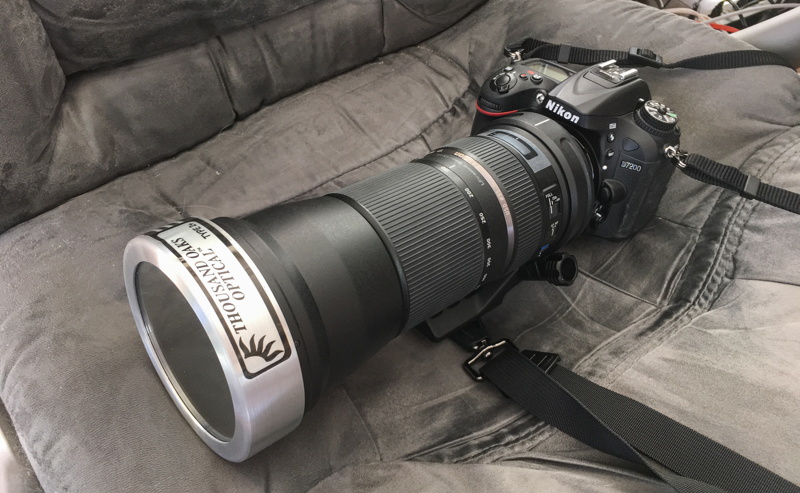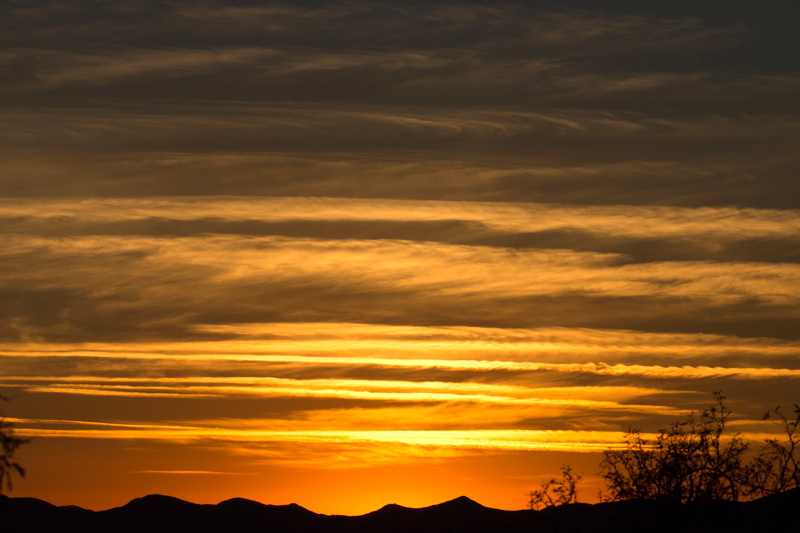Tamron 150-600mm lens tests; Meade Diagonal repair;
Green Flash, ISS
Posted: 4 December 2015
Thursday, 3 December 2015, started out very breezy but clear in the morning. I decided to try out my new Tamron 150-600mm lens that I received the day before (kind of an early Christmas present). While the lens will be used mostly for wildlife photography, it will get some other uses as well, as seen here. Late in the morning I took this tripod mounted photo (cropped) of Kitt Peak National Observatory at a focal length of 600mm (35mm equivalent of 900mm) with my D7200 DSLR. Although wind and ground heating made for a not great image, several of the observatories on the mountain 65 miles from Cassiopeia Observatory are visible.

This is a full-frame photo of the Last Quarter Moon in the daylight sky, handheld, 600mm:

Yes, that photo of the Moon was with the camera handheld!
My Thousand Oaks Optical Solar Filter (from my ETX-90RA telescope) fits nicely on the lens:

This is a full-frame, handheld, 600mm photo of the spotless Sun using the solar filter:

I will be doing additional astrophotography with this lens. I did try mounting it piggyback on the 8" LX200-ACF (as I do with the D7200 DSLR and Nikon 70-300mm lens) but it was too heavy for the telescope. Maybe it will be OK with a better piggyback adapter on the 12" LX600 (still planned for early 2016).
On my last report I mentioned that the Meade 2" Diagonal eyepiece holder tube had become slightly loose. When this happened in January 2014 I tried to fix it myself. Meade had told me about four hidden setscrews beneath the name plates on the diagonal. As you can see from the photos on my report from 28 January 2014, I attempted to repair it but was unsuccessful. That diagonal was replaced under warranty. Since my current one is no longer under warranty I decided to try again. I was successful this time. I discovered that the hidden setscrews on this diagonal (and perhaps on the original one as well) were not hex-headed screws but only required a very small flathead jeweler's screwdriver to tighten them. I only had to do one side to tighten up the tube. I did have to blow off some metal debris that had settled on the mirror when I removed the name plate.
Clouds began showing up in the early afternoon on Thursday. I did do an HD video of the setting Sun to try to capture the "Green Flash" from the distant mountains. Here are two full-frame images from the HD video, 1.3X crop factor, 60 fps, f/6.3, Auto Exposure, FL 600mm:


The second frame barely shows the Green Flash. Clouds were a factor in reducing the effect. Will try again on a clearer evening. And speaking of clouds, this is the view shortly after sunset with the Tamron lens at FL 150mm:

Later in the evening I tried an HD video recording (1.3X crop, 60 fps) of the International Space Station (ISS) as it passed overhead. Some thin clouds hampered the view somewhat. The D7200 DSLR camera was set for f/6.3, 1/1600sec, ISO 4000, FL 600mm, and the camera was mounted on a photographic tripod. I tried tracking the ISS on the camera viewscreen; it was faintly visible. However, the tracking was not smooth. Some detail was captured, as seen this greatly cropped and scaled up 400% image:

So far I am pleased with the Tamron 150-600mm lens on my Nikon D7200 DSLR.
Due to the clouds, the observatory was not opened this night.
Continuing my "10th Anniversary" of my first visits to "Oracle Observatory" in 2005, here is the report from 3 December 2005.
Comments are welcome using Email. If you are on Twitter you can use the button below to tweet this report to your followers. Thanks.
Cassiopeia Observatory Home Page
Copyright ©2015 Michael L. Weasner / mweasner@me.com
URL = http://www.weasner.com/co/Reports/2015/12/04/index.html
